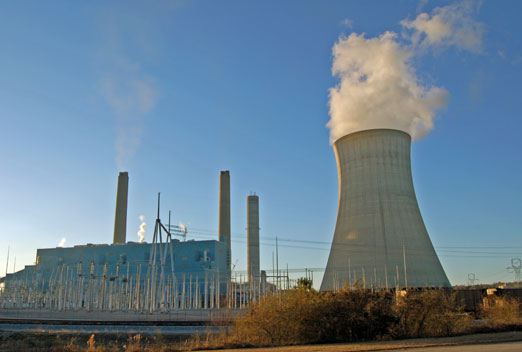
Alabama Power’s Miller Steam Plant on the Locust Fork of the Black Warrior River emits more mercury into the air than any other power plant in the country. It is also a source of fine particulate pollution and ozone, which cause the Ozone allergy or the Ozone Flu: Glynn Wilson
WASHINGTON, D.C. – Based on extensive recent scientific evidence about the harmful effects of ground-level ozone, also known as smog, the Obama administration is proposing to strengthen air quality standards to better protect Americans’ health and the environment.
The Clean Air Act requires the U.S. Environmental Protection Agency to review the standards every five years by following a set of open, transparent steps and considering the advice of a panel of independent experts.
Due to certain realities of politics and legal issues, the agency last updated these standards in 2008, setting the allowable ozone levels from automobiles and industry at 75 parts per billion. The tougher standards would be closer to the EPA’s 2011 proposal, which President Barack Obama unexpectedly withdrew because of cost concerns while the nation was recovering from a recession. Obama directed the EPA to craft a new proposal. When it failed to act, groups including the American Lung Association, the Sierra Club and the Environmental Defense Fund sued for a court-ordered deadline.
The new standards, announced and put out for public comment on Wednesday, would make the standards even tougher in the range of 65 to 70 parts per billion, although federal regulators are even considering going even lower to 60 ppb.
“Bringing ozone pollution standards in line with the latest science will clean up our air, improve access to crucial air quality information, and protect those most at-risk. It empowers the American people with updated air quality information to protect our loved ones – because whether we work or play outdoors – we deserve to know the air we breathe is safe,” EPA Administrator Gina McCarthy said in the announcement. “Fulfilling the promise of the Clean Air Act has always been EPA’s responsibility. Our health protections have endured because they’re engineered to evolve, so that’s why we’re using the latest science to update air quality standards – to fulfill the law’s promise, and defend each and every person’s right to clean air.”
In coming up with the standards, Federal agency scientists examined numerous scientific studies in its most recent review of the ozone standards, including more than 1,000 new studies published since the last update. Those studies indicate that exposure to ozone at levels below 75 ppb — the level of the current standard — can pose serious threats to public health, harm the respiratory system, cause or aggravate asthma and other lung diseases, and is linked to premature death from respiratory and cardiovascular causes.
Ground-level ozone forms in the atmosphere when emissions of nitrogen oxides and volatile organic compounds “cook” in the sun from sources like cars, trucks, buses, industries, power plants and certain fumes from fuels, solvents and paints.
People most at risk from breathing air containing ozone include people with asthma, children, older adults, and those who are active or work outside. Stronger ozone standards will also provide an added measure of protection for low income and minority families who are more likely to suffer from asthma or to live in communities that are overburdened by pollution, the EPA says. Studies show that 1 in 10 children nationally has been diagnosed with asthma.
Environmentalists and health advocates hailed the plan as a way to cut down on asthma, heart disease and other respiratory illnesses.
“EPA’s proposal to strengthen the standard is a vital step forward in the fight to protect all Americans from the dangers of breathing ozone pollution,” American Lung Association President Harold Wimmer said in reaction to the news.
Terry McGuire, the Sierra Club’s Washington representative on smog pollution, said Obama, who is not up for re-election, was now freer to act aggressively and should push the limit down as far as 60 ppb.
“This should be a centerpiece of his environmental legacy,” McGuire said.
According to EPA’s analysis, strengthening the standard to a range of 65 to 70 ppb will provide significantly better protection for children, preventing from 320,000 to 960,000 asthma attacks and from 330,000 to 1 million missed school days. Strengthening the standard to a range of 70 to 65 ppb would better protect both children and adults by preventing more than 750 to 4,300 premature deaths; 1,400 to 4,300 asthma-related emergency room visits; and 65,000 to 180,000 missed workdays.
The agency estimates that the benefits of meeting the proposed standards will significantly outweigh the costs.
“If the standards are finalized, every dollar we invest to meet them will return up to three dollars in health benefits,” the agency says in the announcement.
These large health benefits will be gained from avoiding asthma attacks, heart attacks, missed school days and premature deaths, among other health effects valued at $6.4 to $13 billion annually in 2025 for a standard of 70 ppb, and $19 to $38 billion annually in 2025 for a standard of 65 ppb. Annual costs are estimated at $3.9 billion in 2025 for a standard of 70 ppb, and $15 billion for a standard at 65 ppb.
A combination of recently finalized or proposed air pollution rules – including “Tier 3” clean vehicle and fuels standards – will significantly cut smog-forming emissions from industry and transportation, helping states meet the proposed standards, according to the agency.
EPA’s analysis of federal programs that reduce air pollution from fuels, vehicles and engines of all sizes, power plants and other industries shows that the vast majority of U.S. counties with monitors would meet the more protective standards by 2025 just with the rules and programs now in place or underway.
“Local communities, states, and the federal government have made substantial progress in reducing ground-level ozone,” the agency says. “Nationally, from 1980 to 2013, average ozone levels have fallen 33 percent. EPA projects that this progress will continue.”
The Clean Air Act provides states with time to meet the standards. Depending on the severity of their ozone problem, areas would have between 2020 and 2037 to meet the standards.
To ensure that people are alerted when ozone reaches unhealthy levels, EPA is proposing to extend the ozone monitoring season for 33 states.
“This is particularly important for at-risk groups, including children and people with asthma because it will provide information so families can take steps to protect their health on smoggy days,” the agency says.
The EPA is also proposing to strengthen the “secondary” ozone standard to a level within 65 to 70 ppb to protect plants, trees and ecosystems from damaging levels of ground-level ozone.
New studies add to the evidence showing that repeated exposure to ozone stunts the growth of trees, damages plants and reduces crop yield. The proposed level corresponds to levels of seasonal ozone exposure scientists have determined would be more protective.
EPA will seek public comment on the proposal for 90 days following publication in the Federal Register, and the agency plans to hold three public hearings. EPA will issue final ozone standards by October 1, 2015.
Under the proposal, U.S. states would have from 2020 to 2037 to implement the new standards, based on their current pollution levels. The EPA also cited flexibility to allow for “unique” situations, such as the varied environment of California.
To view the full proposal, hit the link on EPA’s Website.













